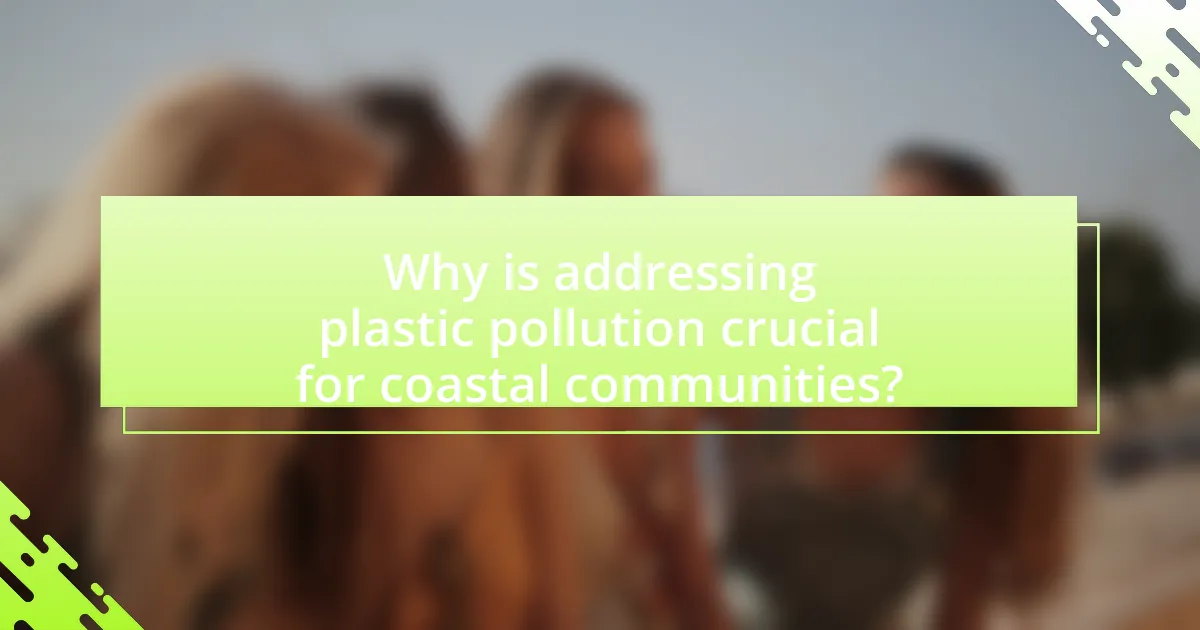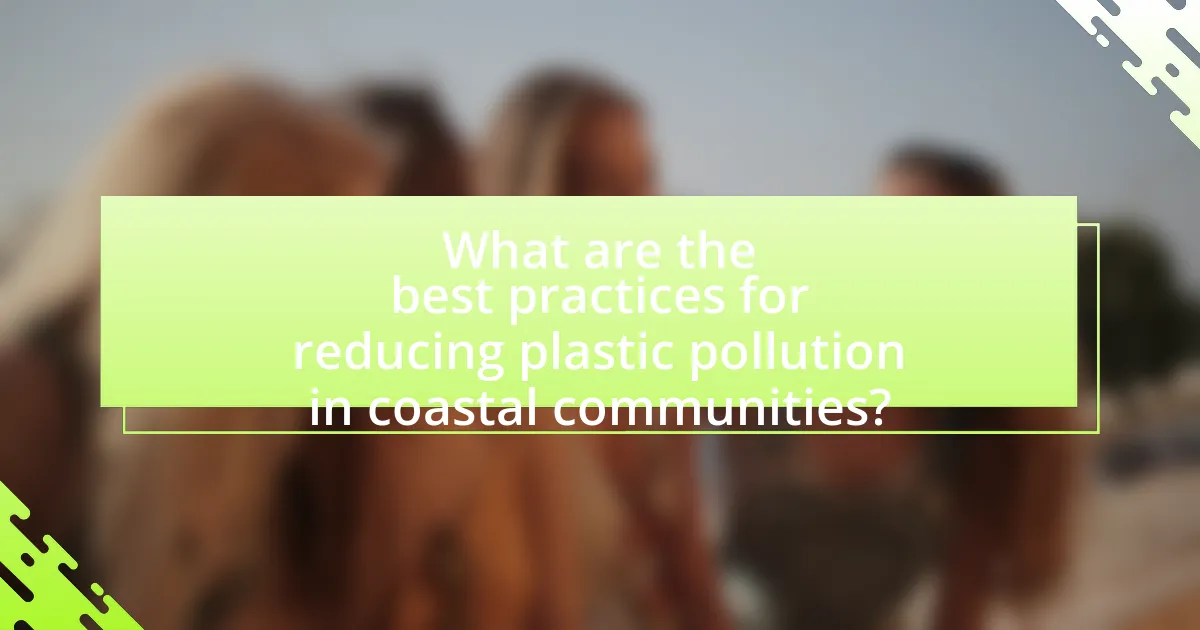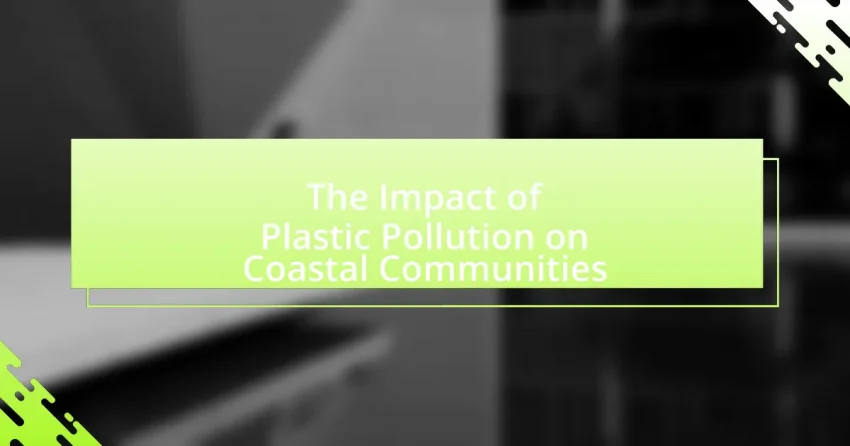Plastic pollution poses a significant threat to coastal communities, adversely affecting marine ecosystems and local economies. The degradation of marine habitats leads to the decline of over 800 species, while economic losses from reduced tourism and fisheries could reach $13 billion annually. Key sources of this pollution include land-based activities, marine operations, and riverine transport, which collectively contribute to the contamination of coastal waters. The article explores the environmental, social, and economic consequences of plastic waste, highlighting the urgent need for community engagement, effective policies, and sustainable practices to mitigate its impact. Additionally, it discusses successful case studies and best practices that can empower coastal communities to combat plastic pollution effectively.

What is the impact of plastic pollution on coastal communities?
Plastic pollution significantly harms coastal communities by degrading marine ecosystems and impacting local economies. The presence of plastic waste leads to the death of marine life, as animals ingest or become entangled in debris, disrupting biodiversity. According to a study published in the journal “Marine Pollution Bulletin,” over 800 species are affected by marine debris, with many facing extinction due to habitat destruction and pollution. Additionally, coastal tourism suffers as polluted beaches deter visitors, leading to economic losses for local businesses. A report from the United Nations Environment Programme estimates that plastic pollution could cost coastal economies up to $13 billion annually in lost tourism and fisheries.
How does plastic pollution affect the environment in coastal areas?
Plastic pollution significantly harms the environment in coastal areas by disrupting marine ecosystems and harming wildlife. The presence of plastic debris leads to ingestion and entanglement of marine animals, which can result in injury or death. For instance, studies indicate that over 800 species are affected by marine debris, with many species mistaking plastic for food, leading to malnutrition or starvation. Additionally, plastic pollution contributes to habitat degradation, particularly in sensitive ecosystems like coral reefs, where it can smother corals and inhibit their growth. Furthermore, microplastics, which are small plastic particles, can accumulate in the food chain, posing risks to both marine life and human health. Research from the United Nations Environment Programme highlights that coastal areas are particularly vulnerable due to their proximity to urban centers and high population densities, exacerbating the impact of plastic waste.
What are the primary sources of plastic pollution in coastal regions?
The primary sources of plastic pollution in coastal regions include land-based activities, marine activities, and riverine transport. Land-based activities, such as improper waste disposal and littering, contribute significantly to plastic debris entering coastal waters. According to the United Nations Environment Programme, approximately 80% of marine plastic pollution originates from land. Marine activities, including fishing and shipping, also add to the problem through lost fishing gear and cargo spills. Additionally, rivers act as conduits, transporting plastics from inland areas to the ocean, with studies indicating that 1,000 rivers account for 80% of global riverine plastic emissions.
How does plastic pollution disrupt marine ecosystems?
Plastic pollution disrupts marine ecosystems by introducing harmful materials that affect marine life and habitats. Marine organisms, such as fish and seabirds, often ingest plastic debris, leading to physical harm, malnutrition, and even death. A study published in the journal “Science” found that over 800 species worldwide are affected by marine debris, with plastic being a significant contributor. Additionally, plastic pollution alters habitats by smothering coral reefs and seagrass beds, which are crucial for biodiversity. The presence of microplastics in the water column can also disrupt the food chain, as smaller organisms consume these particles, leading to toxic accumulation in larger predators.
What social and economic consequences does plastic pollution have on coastal communities?
Plastic pollution has significant social and economic consequences for coastal communities, including harm to local fisheries and tourism. The presence of plastic waste in marine environments leads to the decline of fish populations, which directly impacts the livelihoods of fishermen and the availability of seafood for local markets. For instance, a study by the United Nations Environment Programme reported that plastic pollution can reduce fish stocks by up to 30%, threatening food security and economic stability in these areas. Additionally, the aesthetic degradation caused by plastic waste deters tourists, leading to decreased revenue for businesses reliant on tourism. Research from the World Economic Forum indicates that coastal tourism can suffer losses of up to $1.5 billion annually due to plastic pollution, further exacerbating economic challenges for these communities.
How does plastic pollution affect local fisheries and livelihoods?
Plastic pollution significantly harms local fisheries and livelihoods by contaminating marine ecosystems and reducing fish populations. The presence of plastics in water bodies leads to the ingestion of microplastics by fish, which can cause health issues and decrease reproductive success. According to a study published in the journal “Environmental Pollution,” over 200 species of marine organisms have been documented to ingest plastic debris, impacting their survival rates. This decline in fish populations directly affects local fishermen’s income and food security, as they rely on healthy fish stocks for their livelihoods. Furthermore, the economic repercussions extend to communities dependent on fishing tourism, as polluted waters deter visitors and reduce overall economic activity.
What are the health implications for residents of coastal communities?
Residents of coastal communities face significant health implications due to plastic pollution. Exposure to microplastics in seafood can lead to various health issues, including gastrointestinal problems and potential endocrine disruption. A study published in Environmental Science & Technology found that microplastics can accumulate in marine organisms, which are then consumed by humans, raising concerns about long-term health effects. Additionally, plastic waste can contribute to water contamination, increasing the risk of waterborne diseases among residents. The presence of plastics in coastal environments also affects mental health, as degraded natural landscapes can lead to decreased well-being and increased stress levels.

Why is addressing plastic pollution crucial for coastal communities?
Addressing plastic pollution is crucial for coastal communities because it directly impacts their economic stability, environmental health, and public safety. Coastal communities rely heavily on marine resources for tourism, fishing, and recreation, which are threatened by plastic debris that harms marine life and ecosystems. For instance, a study by the United Nations Environment Programme reported that plastic pollution costs the global economy up to $13 billion annually in damages to marine ecosystems, affecting livelihoods in coastal areas. Additionally, plastic waste can lead to health risks for local populations through contaminated seafood and polluted beaches, further emphasizing the need for effective management and reduction of plastic pollution in these vulnerable regions.
What role do coastal communities play in combating plastic pollution?
Coastal communities play a crucial role in combating plastic pollution by actively engaging in cleanup efforts, advocating for policy changes, and promoting sustainable practices. These communities often organize beach cleanups, which have been shown to remove significant amounts of plastic waste from shorelines; for instance, the Ocean Conservancy’s International Coastal Cleanup has documented over 1.5 million volunteers collecting more than 23 million pounds of trash annually. Additionally, coastal residents frequently collaborate with local governments to implement regulations aimed at reducing plastic use, such as bans on single-use plastics. Their involvement in education and awareness campaigns further empowers individuals to adopt environmentally friendly behaviors, thereby contributing to the reduction of plastic pollution in marine environments.
How can community engagement enhance plastic pollution mitigation efforts?
Community engagement can enhance plastic pollution mitigation efforts by fostering local ownership and responsibility for environmental stewardship. When communities actively participate in initiatives such as clean-up drives, educational programs, and policy advocacy, they develop a stronger connection to their local ecosystems, which motivates sustainable behaviors. Research indicates that community-led initiatives can lead to a 30% reduction in plastic waste in coastal areas, as seen in the “Community-Based Coastal Resource Management” study published by the Coastal Management Journal. This demonstrates that engaged communities are more likely to implement effective waste management practices and support policies aimed at reducing plastic pollution.
What are successful case studies of coastal communities addressing plastic pollution?
Successful case studies of coastal communities addressing plastic pollution include the initiatives in Kamilo Beach, Hawaii, and the city of Capannori, Italy. Kamilo Beach has implemented community-led clean-up efforts that have significantly reduced plastic debris, with volunteers regularly collecting thousands of pounds of plastic waste. In Capannori, the local government has introduced a comprehensive waste management program that includes strict regulations on single-use plastics, resulting in a reported 30% reduction in plastic waste within two years. These examples demonstrate effective community engagement and policy implementation in combating plastic pollution.
What policies and regulations are in place to tackle plastic pollution in coastal areas?
Governments and international organizations have implemented various policies and regulations to address plastic pollution in coastal areas. For instance, the European Union’s Marine Strategy Framework Directive mandates member states to achieve good environmental status of their marine waters, which includes reducing marine litter, particularly plastics. Additionally, the United States has enacted the Save Our Seas Act, which aims to improve the federal response to marine debris and enhance international cooperation to combat plastic pollution. These regulations are supported by scientific studies indicating that effective policy frameworks can significantly reduce plastic waste entering coastal ecosystems, thereby protecting marine biodiversity and coastal communities.
How effective are current regulations in reducing plastic waste?
Current regulations are moderately effective in reducing plastic waste, with varying success across different regions. For instance, the European Union’s Single-Use Plastics Directive aims to reduce the consumption of specific plastic products, leading to a reported 30% decrease in single-use plastic consumption in member states since its implementation in 2021. However, enforcement and compliance issues persist, as many countries lack the infrastructure to support proper waste management and recycling. Additionally, studies indicate that while regulations can lead to short-term reductions in plastic waste, long-term effectiveness hinges on public awareness and behavioral change, which are often not adequately addressed in regulatory frameworks.
What additional measures can be implemented to protect coastal communities?
To protect coastal communities from the impact of plastic pollution, implementing comprehensive waste management systems is essential. These systems should include increased recycling facilities, public education campaigns on waste reduction, and stricter regulations on single-use plastics. For instance, a study by the United Nations Environment Programme indicates that effective waste management can reduce plastic leakage into oceans by up to 80%. Additionally, establishing marine protected areas can help preserve local ecosystems, which are vital for community resilience against pollution.

What are the best practices for reducing plastic pollution in coastal communities?
The best practices for reducing plastic pollution in coastal communities include implementing comprehensive waste management systems, promoting community clean-up initiatives, and encouraging the use of sustainable alternatives to single-use plastics. Comprehensive waste management systems, such as recycling programs and proper disposal facilities, can significantly decrease the amount of plastic waste entering coastal environments. Community clean-up initiatives, which engage local residents in removing plastic debris from beaches and waterways, have been shown to raise awareness and foster a sense of responsibility towards the environment. Additionally, promoting sustainable alternatives, such as reusable bags and containers, can reduce reliance on single-use plastics, which are a major contributor to coastal pollution. According to a study published in the journal “Marine Pollution Bulletin,” effective waste management and community engagement can lead to a measurable decrease in plastic pollution levels in coastal areas.
How can individuals contribute to reducing plastic pollution?
Individuals can contribute to reducing plastic pollution by adopting sustainable practices such as minimizing single-use plastics, recycling properly, and participating in community clean-up efforts. By choosing reusable bags, bottles, and containers, individuals can significantly decrease the demand for plastic products, which are a major contributor to pollution. According to the United Nations, approximately 300 million tons of plastic are produced each year, with a significant portion ending up in oceans, harming marine life and coastal ecosystems. Engaging in local clean-up initiatives not only helps remove existing plastic waste but also raises awareness about the issue, fostering a community commitment to reducing plastic use.
What lifestyle changes can residents adopt to minimize plastic use?
Residents can minimize plastic use by adopting practices such as using reusable bags, bottles, and containers. By replacing single-use plastics with durable alternatives, individuals can significantly reduce their plastic footprint. For instance, studies indicate that switching to reusable bags can prevent the use of approximately 500 plastic bags per person annually. Additionally, opting for bulk purchasing reduces packaging waste, as bulk items often come with minimal or no plastic. Implementing these changes not only contributes to less plastic pollution but also promotes sustainable living within coastal communities, which are particularly vulnerable to the impacts of plastic waste.
How can local businesses participate in reducing plastic waste?
Local businesses can participate in reducing plastic waste by implementing sustainable practices such as eliminating single-use plastics, offering reusable alternatives, and promoting recycling initiatives. For instance, businesses can replace plastic straws and bags with biodegradable or reusable options, which directly decreases the amount of plastic entering the waste stream. According to a report by the Ellen MacArthur Foundation, transitioning to reusable packaging could reduce plastic waste by 80% by 2040, highlighting the significant impact local businesses can have on this issue. Additionally, businesses can collaborate with local organizations to support community clean-up events, further contributing to the reduction of plastic pollution in coastal areas.
What community initiatives can be established to combat plastic pollution?
Community initiatives that can be established to combat plastic pollution include organizing regular beach clean-up events, implementing educational programs about the effects of plastic waste, and promoting local recycling efforts. Beach clean-up events engage community members in removing plastic debris from coastal areas, directly reducing pollution levels. Educational programs can raise awareness about the environmental impact of plastic, encouraging responsible consumption and waste management practices. Additionally, promoting local recycling initiatives can facilitate proper disposal and recycling of plastics, thereby minimizing their presence in coastal ecosystems. According to the United Nations Environment Programme, community-led clean-up efforts have been shown to significantly reduce plastic waste in marine environments, highlighting the effectiveness of these initiatives.
How can educational programs raise awareness about plastic pollution?
Educational programs can raise awareness about plastic pollution by integrating comprehensive curricula that focus on the environmental, economic, and health impacts of plastic waste. These programs can include hands-on activities, workshops, and community engagement initiatives that encourage participants to understand the sources and consequences of plastic pollution. For instance, studies show that educational interventions can significantly increase knowledge and change attitudes towards plastic use, as evidenced by a 2019 study published in the Journal of Environmental Education, which found that students exposed to targeted educational content demonstrated a 40% increase in awareness regarding plastic pollution. By fostering critical thinking and promoting sustainable practices, educational programs can effectively empower individuals and communities to take action against plastic pollution.
What partnerships can be formed to enhance plastic pollution reduction efforts?
Collaborations between governments, non-governmental organizations (NGOs), businesses, and local communities can significantly enhance plastic pollution reduction efforts. For instance, government partnerships with NGOs can facilitate awareness campaigns and educational programs aimed at reducing plastic use. Businesses can collaborate with local governments to implement recycling initiatives and develop sustainable packaging solutions. Additionally, community engagement through partnerships with local organizations can foster grassroots movements that promote clean-up events and responsible waste management practices. Evidence shows that such multi-stakeholder collaborations lead to more effective policy implementation and increased public participation, ultimately resulting in reduced plastic pollution in coastal areas.
